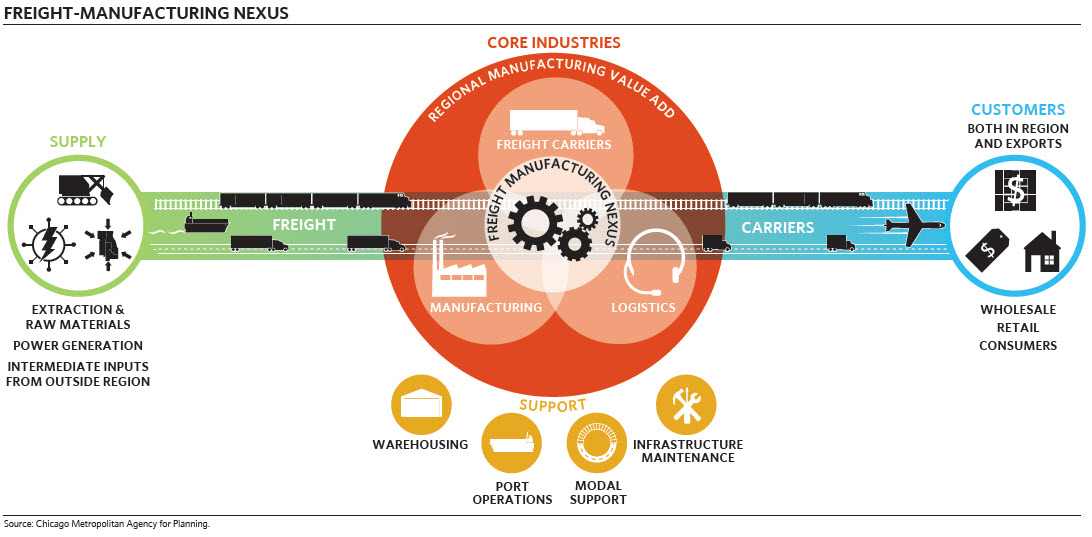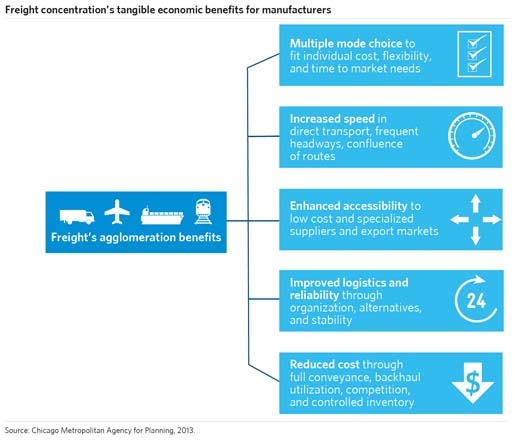Metropolitan Chicago's clusters of specialized industries play a critical role in creating quality jobs and contributing to the overall regional economy's value-adding output, as noted by GO TO 2040. Prior CMAP research has focused on the region's freight and manufacturing clusters -- two of metropolitan Chicago's historic strengths -- to show opportunities for growth in the new global economy. CMAP's new report, The Freight-Manufacturing Nexus: Metropolitan Chicago's Built-in Advantage, complements this work by documenting how the region's unique synergy of interdependent freight and manufacturing assets means metropolitan Chicago is well-positioned to compete in the nation's recent manufacturing resurgence.

Click for larger image.
Recent Freight and Manufacturing Employment Growth
CMAP's freight-manufacturing nexus consists of three core industries -- freight carriers, logistics providers, and manufacturing firms--that together underpin the region's impressive industrial output. Combined, these three industries have helped lead the region out of the economic recession; while the core nexus industries account for about ten percent of total regional employment, they were responsible for more than 20 percent of all jobs created here from 2010-12. The following chart shows how recent growth in these three industries has outpaced the rest of the regional economy.

Click for larger image.
In the chart, circle size indicates current employment by industry while the horizontal axis depicts freight, logistics, and manufacturing's striking employment gain compared to the rest of the regional economy. In the past two years, employment in the region's freight-manufacturing nexus has increased by seven percent, more than double the rest of the regional economy's average of 2.8 percent growth. Furthermore, the increase in location quotient (measured on the vertical axis) for each of the nexus industries means metropolitan Chicago has become more specialized in freight and manufacturing compared to the national average.
Benefits of Co-Location
The bulk of CMAP's nexus report focuses on how the region's unique co-location of freight firms and infrastructure provides tangible economic benefits for regional manufacturing. Metropolitan Chicago has more major interstates and railroads than anywhere else in the nation, as well as developed air and water facilities. Together with the nation's second largest concentration of freight workers, this unparalleled freight access provides manufacturers here mode choice to meet specific supply chain needs; offers more direct routes and headways; increases access to suppliers and markets; improves logistics and reliability; and lower costs through concentrated demand, inventory control, and competition. In short, the region's freight system serves as a regional competitive advantage, helping translate recent manufacturing momentum into regional economic growth.
Maintaining Competitive Edge
Few other domestic regions can emulate the scale and scope of metropolitan Chicago's unique concentration in both freight and manufacturing. With this entrenched freight-manufacturing nexus, metropolitan Chicago is literally well-position to compete in the increasingly global economy. Perhaps more than many other regions, CMAP's recent analysis shows how metropolitan Chicago's economic prosperity depends on the interconnection between productivity and regional freight mobility. The report's findings echo GO TO 2040's recommendations around mobility, underscoring how in order for the region to fully realize current potential and support long-term economic growth, we must make the strategic infrastructure investments that improve connectivity and allow manufacturers to continue to leverage the region's strengths in freight as a unique competitive advantage.
The full report is available at www.cmap.illinois.gov/policy/drill-downs.
